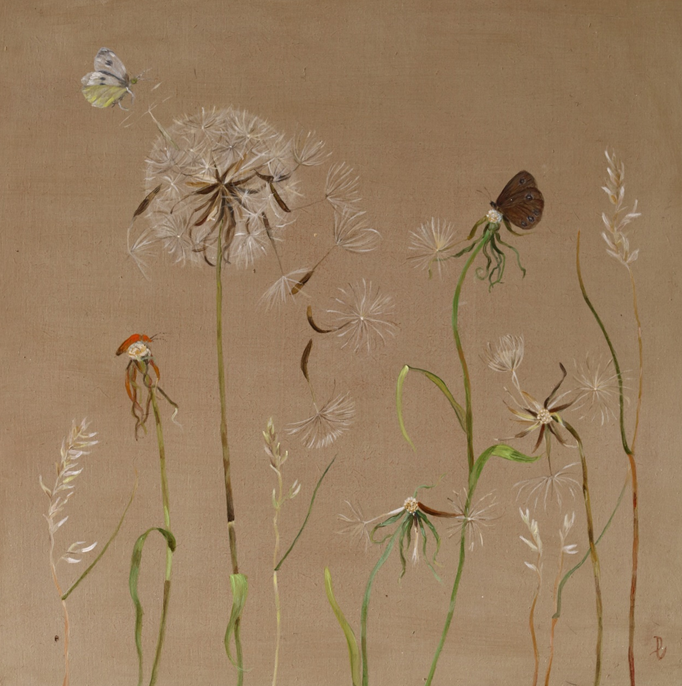My delight in these little creatures came from an unexpected discovery. Leaving the house one morning, I noticed on the wall by my front door, a beautiful white moth. I had always associated moths with the lurching brown fluttering things that, as a child, would make me scream as they flitted around my bedside lamp.

The Ermine Moth, oil
This was different. It was a thing of such beauty that I just paused and gazed at its diaphanous, ethereal wings dotted with chocolate brown patches. I took a photograph with my phone and this led me down the rabbit hole to find out more. The moth in question was an Ermine moth and the other thing I discovered was that they have the most romantic, poetic names. Victorian naturalists had been smitten too and named them such evocative epithets as the Scalloped Oak, the Muslin moth or the Hebrew Character.
I started to look for more and obtained a moth trap, a box with a light above that attracts them to the dark corners inside, where they fall asleep. Each morning is like Christmas as you open the lid to peer at who has visited overnight.

Muslin Moths, oil
They are the perfect, obliging models, who sleep during the day. I take two or three into my studio to identify and draw, where they remain perfectly still. Nothing compares with drawing from life. You can examine their intricate patterns and subtle colour combinations and see details that you would never see from a photograph. Some are marked like Florentine embroidery; others are vibrant with wings of shocking pink and lime.

The Angle Shades moth posing for my drawings

The Purple Thorn Moth
I have to work quickly. I like to keep them with me for as short a time as possible and so my drawings at this stage are little more than sketches. I use pencil and watercolour to try to capture their most individual features and make colour notes and a little description of their habitat and food plants. I then carry them back to the garden, placing them carefully in a place they will feel comfortable until night fall when they will dance again under darkness.

In a Summer Meadow, oil
I have kept my “moth diaries” now for a couple of years. They are a record of my otherwise unseen visitors through the year, but they also provide an opportunity to sit quietly and draw mindfully. Their smallness makes you really observe and focus. Some are very difficult to capture, as their colours are so subtle and their markings so intricate, but I enjoy the challenge. Most importantly, they are done for pleasure. They are recorded in my sketchbook, where like everything I draw there, they have been created because they are something that has delighted or intrigued me.
Occasionally they re-emerge in my art work, either in oil paintings, or in tiny pen and ink drawings, where I try to draw attention to their patterns.

The Argent and Sable Moth, pen and ink

The Garden Carpet Moth, pen and ink
This year they have been an especially welcome distraction. They have provided a calm, meditative activity that has lifted me out of the worries of lockdown providing a space where I can enjoy the beauty of the natural world. Drawing the small beauties of nature, whether it be wild verge-side flowers, grasses or moths, is a balm in our troubled times, so by choosing a subject like this, that is often overlooked, may lead to down your own rabbit hole to discover your own more unexpected delights.

Night Garden, oil
Watch the following videos of Deborah's moth diaries:
See more from Deborah on her website, www.deborahvass.com and in the PaintersOnline gallery by clicking here.













Comments
Login or register to add a comment
No comments